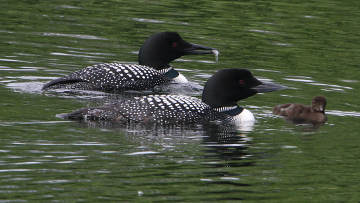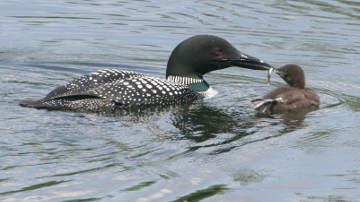

PHOTO COURTESY OF GARRY KESSLER
A pair of loons in breeding plumage with their downy black chick on Wachusett Reservoir in June 2014.
May 27, 2016, Page A6
NATURE NOTES
By Annie Reid
Westborough Community Land Trust
Loons in Massachusetts
Only rarely does someone glimpse – or hear – a loon on one of our larger local lakes, typically during migration season in spring or fall, when some of these birds that we associate with the northern wilderness pass through our area.
In Massachusetts common loons (Gavia immer) are listed as a species of special concern, although they’ve made a bit of a comeback in recent decades. Why would a migrating loon have to stop over on a larger lake, such as Westborough’s Mill Pond (SUASCO) or Lake Chauncy, rather than a small pond as some ducks do?
Although loons are light enough to fly, at 8-12 pounds they are heavy enough to need considerable room to take off into the air. They literally run over the water’s surface for 30 yards or more, flapping their wings, in order to become airborne. Loons have to be careful not to land on a lake that’s too small, or by mistake on a wet roadway or parking lot that looks to them like water.
If a loon does land in such a place, it won’t be able to take off again. But why aren’t loons lighter? Their weight helps them dive. They live most of their lives on water, and they dive for fish, which they chase underwater. They can go as deep as 150 feet but more typically dive about nine feet. Their bones are heavier, with fewer air-filled spaces, than the bones of most birds. When loons dive, they also get rid of extra air that would tend to make them float. They exhale, flatten their feathers against their body, and flatten some of the internal air sacs in their breathing system.
With less oxygen available, their heart slows, allowing them to stay underwater for long periods – up to 15 minutes, but usually 40 seconds to three minutes.
Once in the air, loons can fly up to 70 miles per hour when migrating.
Most loons passing through our area are headed to large lakes farther north in the U.S. (such as New Hampshire’s Lake Winnipesaukee) and Canada, but since 1975 small numbers of loon pairs breed in Massachusetts. You might find them on large, relatively undisturbed bodies of water, such as nearby Wachusett Reservoir and Quabbin Reservoir.

PHOTO COURTESY OF GARRY KESSLER
A loon feeds a small fish to its chick on Wachusett Reservoir, June 2014.
On Wachusett Reservoir loons have nested on floating rafts with canopies, put out by state environmental agents. These small artificial islands can be easier to spot than the loons themselves.
Where else might you see a common loon? Look for them off Cape Cod and the Islands in summer. In fall and winter you might spot loons close to shore off the Atlantic coast, as well as on large lakes with open water.
Loons have salt glands that remove salt from their bodies, so they can live on salt water as well as fresh water. At this time of year, both male and female common loons are handsome in their breeding plumage, with black-and-white checkered backs, black heads and beaks, and red eyes. They are 28-36 inches long with a wing span of 49-58 inches – closer to the size of a goose than a mallard duck.
Their appearance is less striking outside of the breeding season, when they have a gray back, white throat, and gray bill. Loon pairs typically have only one or two chicks, unlike the ducks or geese which you might see trailing a long line of chicks swimming after them. The very young loon chicks sometimes ride on a parent’s back and stay there even when the parent dives. You are more likely to hear loons farther north, where more of them commonly breed, than around here, but you might hear a loon call used as a wilderness sound effect in a TV show or a movie. Their famous haunting wail, given between mates, seems like the howl of a coyote or wolf.
Their wavering call, given when a loon is alarmed, often makes people think of crazy or “loony” laughter. Males also make long, complex yodel calls, especially when advertising or defending territory. To hear loon calls, go to https://www.allaboutbirds.org/guide/Common_Loon/sounds.
These days loons are viewed as sentinels that indicate environmental quality. They are quite sensitive to environmental hazards, ranging from human disturbance (boats, motors) and lakeside development that can disrupt their breeding, to various pollutants that can harm the loons or their food supply. Tufts veterinarian and loon researcher Mark Pokras notes that common loons suffer lead poisoning when they swallow fishing gear. They pick it off the bottom of lakes along with the pebbles they need in their gizzard to help digest fish bones. Acid in their stomach dissolves fishing sinkers and jigs, releasing lead that then poisons the loon. People can help loons and the environment by switching to iron, tungsten, or other metals for fishing gear, to copper and other metals for bullets, and to nontoxic shot for hunting waterfowl or skeet and trap shooting.
Acid rain, due to pollutants from power plants and vehicles, can lead to lakes being contaminated with mercury, which also poisons loons. Acid rain can also affect the fish in lakes, diminishing the loons’ food supply.
Common loons are found around the world in the northern hemisphere, but we’re lucky to have them here in New England. Even if you don’t get to see or hear one, enjoy knowing they’re out there.